5 Best Grass Seeds for Kansas
BY LASHONDA TUCKER | MAY 22ND, 2023 | KANSAS, LAWN CAREA fruitful walk on one of the Tallgrass Prairie National Reserve’s hiking trails is invigorating. So is returning home to a beautiful lawn reminiscent of the recreational and enlightening journey. This article highlights four of the best grass seeds for Kansas, so you can bring as much of the nostalgia home with you as possible.
Whether it’s the humid, rainy, and warm eastern region of Kansas, the drier, cooler western side of the state, or the central region that has a climate in between, you’ll find grass that is a good match for your home and lifestyle.
In this article:
- Warm-Season vs. Cool-Season Grasses
- 5 Grasses for Kansas
- FAQ About Kansas Grass Seeds
- Choosing Plant and Grass Varieties for Your Kansas Landscape
Warm-Season vs. Cool-Season Grasses
Options for grass types include warm-season grasses and cool-season grasses. Kansas is in the transition zone, where both types of grasses thrive.
Warm-season grasses grow best in the summer. This grass type prefers humid and hot climates and thrives in regions with short, hot summers and mild winters. Warm-season grasses go dormant in the winter and turn brown in cold temperatures. These grasses are commonly found in the southern part of the United States.
Cool-season grasses grow best in the spring and fall. Like warm-season grass, cool-season grass goes dormant in freezing temperatures, too. However, the grass goes dormant later in the winter than warm season-grasses. Cool-season grasses, unlike warm-season grasses, also go brown and dormant in the summer.
Cool-season grass prefers air temperatures between 60 and 75 degrees Fahrenheit. This grass type is typically found in the northern regions of the country where the climate is cool to mild.
5 Grasses for Kansas
Since Kansas is in the transition zone (which means it experiences both hot summers and freezing winters), both warm-season and cool-season grasses can grow in the state. Let’s take a look at the traits, advantages, and disadvantages of each.
Cool-Season grasses:
Warm-Season grasses:
1. Tall Fescue
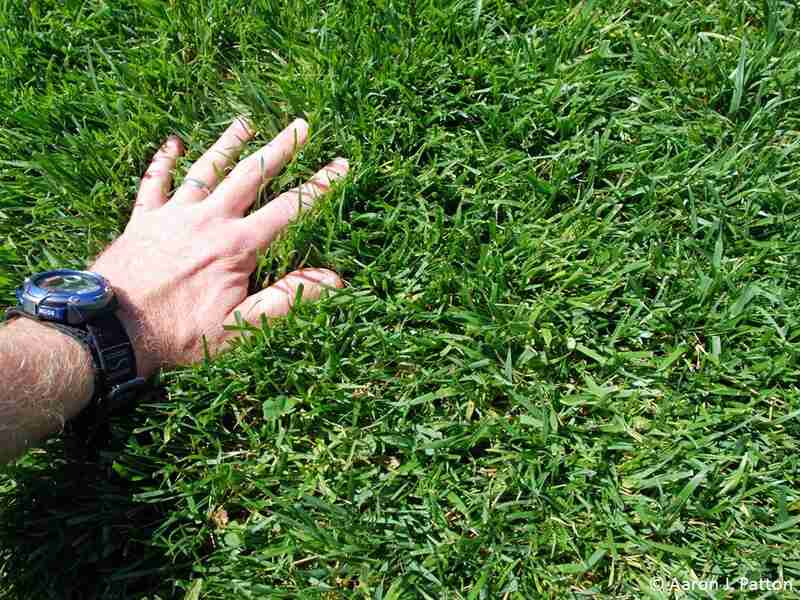
Photo Credit: Aaron Patton / Purdue’s Turfgrass Science Program
Tall fescue has the most heat and drought tolerance of the cool-season grasses, making it ideal for the transition zone. It adapts to a variety of soil types and soil pH levels. Its versatile nature makes it an excellent choice for the Kansas climate, since tall fescue is both heat and cold-tolerant.
Tall fescue is well-adapted to shady conditions, so if your property has trees blocking the sunlight, tall fescue grass seeds will still produce a beautiful lawn.
This grass is low maintenance compared to other grasses. For example, it requires regular mowing, but unlike Kentucky bluegrass, tall fescue does not have high fertilization requirements. Thatch and diseases are also not significant problems for tall fescue.
Tall fescue has a glossy, dark green color and coarse texture. It has moderate foot traffic. This grass can tolerate occasional physical activity, but it does not recover from damage like Kentucky bluegrass.
During long dry spells, tall fescue requires frequent mowing and irrigation to keep it healthy.
Classification: Cool-season grass
Spreads by: Produces short rhizomes but has a bunch-type growth habit
Shade tolerance: Moderate
Drought tolerance: Moderate to High
Foot traffic tolerance: Moderate
Maintenance needs: Frequent mowing. Does not produce significant thatch.
Mowing height: Set mowing height to 2 inches when the grass reaches 3 inches tall.
Potential for disease: Tolerant of most diseases when properly maintained.
Soil pH: 5.5-6.5
Soil type: Adapted to a wide range of soil conditions, but prefers fertile clay soils with good drainage.
Other notes: Choose turf-type tall fescue grass seed and avoid forage-type varieties, as they do not produce quality lawns. Rebel tall fescue turfgrass is an ideal option for establishing a lawn because the variety spreads quickly, meaning fewer grass seeds are required for a full canvas.
2. Kentucky Bluegrass
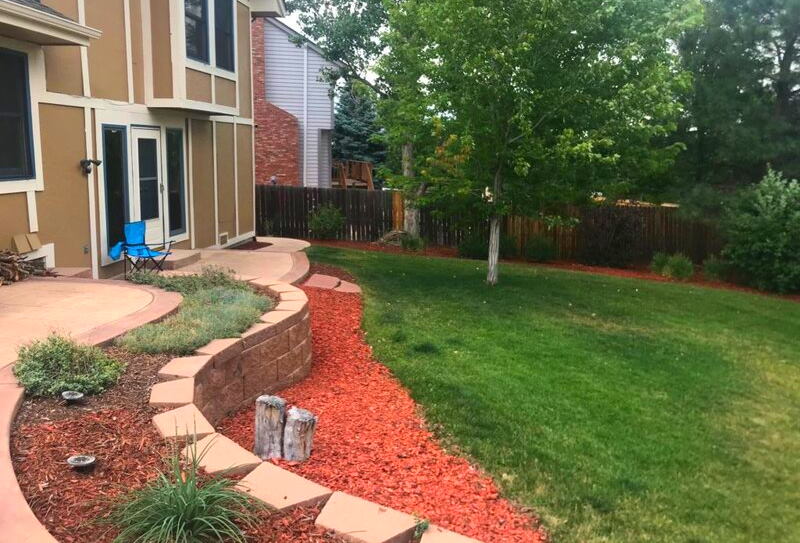
Photo Credit: Brenda Ryan / Wikilawn
Kentucky bluegrass is not as drought-tolerant as tall fescue. Bluegrass also does not perform well in high heat and requires a lot of irrigation in dry, hot weather. It is not recommended for the transition zone as a monostand. While bluegrass may not be the best choice to use alone, it is a good option as a grass seed mix with tall fescue.
Combining the two types of grass seeds makes both types of grass stronger for an overall, healthier lawn that can withstand diseases better. For example, diseases that affect tall fescue may not affect Kentucky bluegrass, and vice versa. Mix at a 9 to 1 ratio of tall fescue to Kentucky bluegrass for optimal results.
Although it is not recommended for the transition zone, Kentucky bluegrass is used in the northeastern part of Kansas where there is ample rainfall. Bluegrass is also used in the northwestern parts where the summer nights have cooler temperatures. Supplemental irrigation is required in the northwestern region.
Bluegrass has some qualities that are complementary to tall fescue. For example, bluegrass has moderate foot-traffic tolerance and quickly recovers from damage. Bluegrass also helps prevent erosion.
Combining bluegrass, with its soft texture and quick recovery from damage, with tall fescue can give you a lawn that is ideal for children running, playing, and falling on the grass regularly.
Classification: Cool-season grass
Spreads by: Rhizomes
Shade tolerance: Low
Drought tolerance: Moderate
Foot traffic tolerance: Moderate
Maintenance needs: Moderate mowing frequency and high fertilization needs.
Mowing height: Set mowing height between 2.5 and 3.5 inches.
Potential for disease: Moderate to high; prone to several diseases, such as dollar spot, leaf spot, necrotic ring spot, summer patch, and stripe smut.
Soil pH: 6-7.5
Soil type: Performs best in well-drained, heavy soils with high fertility.
Other notes: Use the less aggressive cultivars when mixing with tall fescue. Some cultivars that do well under low-maintenance and minimal watering are Caliber and Northstar.
3. Zoysiagrass
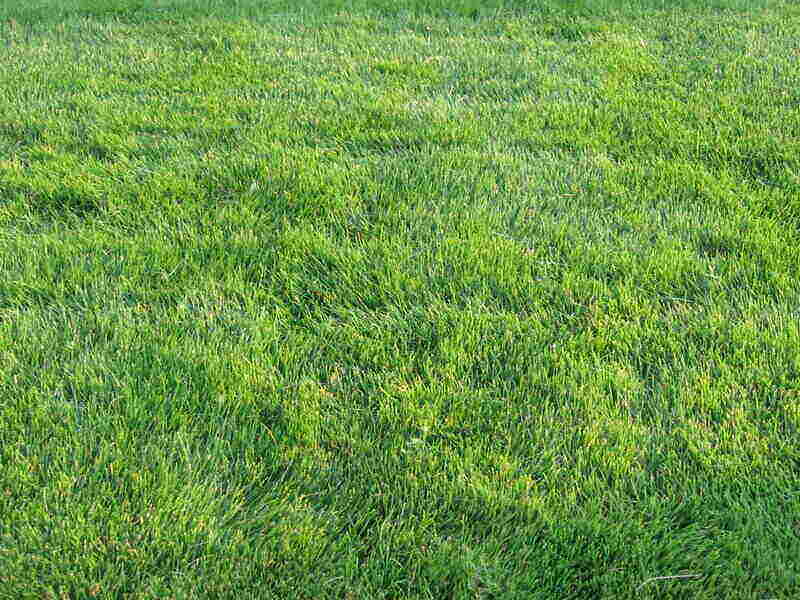
Photo Credit: Russbach at the English Wikipedia / Wikimedia Commons / CC BY-SA 3.0
Zoysiagrass is commonly used for golf courses and by many American homeowners in home lawns. It has high traffic and wear tolerance. Zoysia also adapts well to different soil types.
This grass type grows slowly. So although it has moderate to high maintenance needs, you will not have to run the lawn mower as often to keep the grass low-cut and well-groomed. Another advantage is that its dense turf tends to suppress weeds.
Meyer Zoysia is known for being a quality turf with more winter hardiness than other warm-season grasses typically found in the Midwest. This variety also has good drought and heat tolerance.
Zoysiagrass will grow well on properties with moderate shade. If your home has a lot of trees or does not get a lot of sun, this grass type is a better choice than some other warm-season grasses, like buffalo grass. However, too much shade causes zoysia to thin.
Although zoysia is drought tolerant, it needs supplemental irrigation during long dry spells. Be mindful that thatch can be a problem if this grass type is watered or fertilized too much.
Zoysia comes with some ambivalence. Its high traffic quality makes it a good choice for homes with a lot of physical activity on the lawn, but it recovers slowly from damage. If you want grass that can withstand frequent lawn parties and recover quickly from the traffic, a mixture of tall fescue and Kentucky bluegrass seeds is a better choice.
Classification: Warm-season grass
Spreads by: Stolons and rhizomes
Shade tolerance: Moderate
Drought tolerance: Moderate
Foot traffic tolerance: High, but recovers slowly from damage
Maintenance needs: Moderate to High. It needs to be watered, mowed, and fertilized properly to reduce the need for pesticides. Over-fertilizing it with nitrogen may produce a thick layer of thatch.
Recommended mowing height: 1 and 2 inches
Potential for Disease: Moderate
Soil pH: 6-6.5
Soil type: Thrives in well-draining soil, some cultivars are more tolerant of a wide range of soils than others
Other Notes: It is susceptible to dollar spot and large patch disease. Zoysia grass is vulnerable to white grubs and mole crickets, which attract critters that also cause damage.
4. Buffalograss
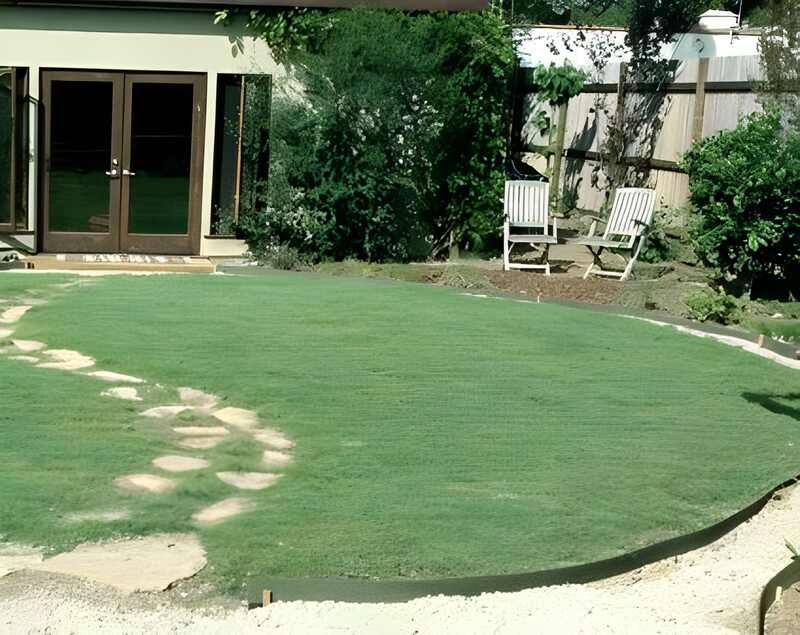
Photo Credit: Susan Harris / Flickr / CC BY 2.0
Buffalograss thrives best in the western area of Kansas where there is less rainfall. This drought-tolerant grass is ideal for homeowners who want a low-maintenance lawn. It requires very little fertilizer or water.
Buffalograss prefers full sun and will not grow at its best on shady properties. Unlike zoysiagrass, buffalograss requires weed management. Mowing regularly, however, can decrease certain types of weeds, like broadleaf weeds. Buffalo is disease and insect tolerant, so it does not need the maintenance that some grasses, like zoysia, require to keep it pest free.
Buffalograss has a unique blue-green color and soft texture. It’s a good option for homes with children who like to walk barefoot across the grass. On the other hand, its low traffic tolerance makes it a less inviting choice for frequent sports activities or gatherings on the lawn.
Classification: Warm-season grass
Spreads by: Stolons
Shade tolerance: Low
Drought tolerance: High
Foot traffic tolerance: Low
Maintenance needs: Low fertilizer and mowing needs. Develops thatch and requires weed control.
Mowing height: Set the mowing height between 2 and 3 inches.
Potential for disease: Good insect and disease resistance
Soil pH: 6.5-7.5
Soil type: Native clay soils, not sandy soils
Other notes: It has no rhizomes or underground stems and is easily destroyed by cultivation. But these qualities make buffalograss easier to remove from your garden and flower bed.
5. Bermudagrass
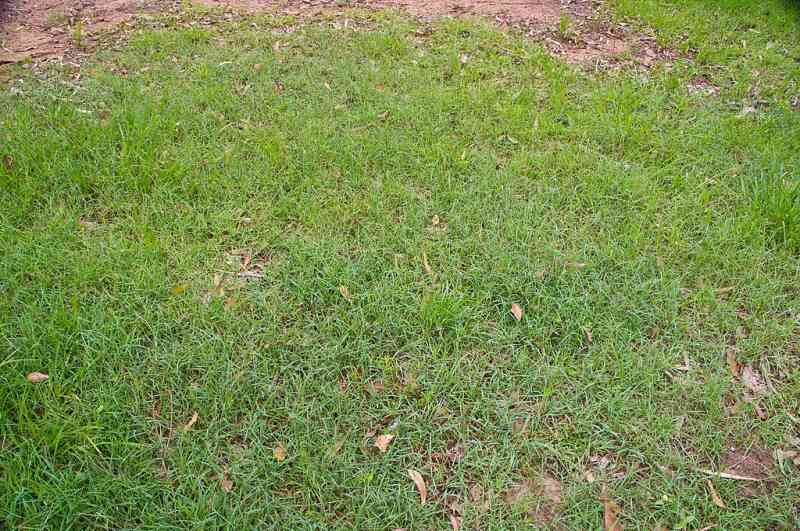
Photo Credit: John Robert McPherson / Wikimedia Commons / CC BY-SA 4.0
Bermudagrass is commonly used throughout the United States. This grass has mixed reviews about its suitability for Kansas.
The University of Missouri reports that bermudagrass is not recommended for lawns in the transition zone. Varieties are predominantly developed in the south and not adapted for Kansas. This grass type has poor cold tolerance. Most seeded varieties lack the resilience to survive the cold Kansas winters.
Nevertheless, bermudagrass is used widely in Kansas. According to Kansas State University, bermudagrass is adapted to the northern edge of the state and can grow well in that area. KSU suggests using cold-tolerant varieties and that they must be planted by vegetative means.
The same source reports that seeded cultivars will thrive in southern Kansas. Cheyenne, Sun Devil, and Guymon are some of the recommended cultivars.
Bermudagrass is medium-green in color and has a texture that is medium-fine. It is heat and drought-tolerant.
This grass type tolerates a wide variety of soil types and has a low-growth habit. A property that receives a lot of sun will provide good growing conditions for bermuda. It can tolerate a few hours of daily shade, but too much time in the shade reduces the grass’s quality and density. Bermuda grows aggressively and can invade gardens and flower beds.
Bermudagrass has high-traffic tolerance and recovers quickly. It is a wonderful selection for homeowners that host frequent play dates on the grass.
Classification: Warm-season grass
Spreads by: Stolons and rhizomes
Shade tolerance: Low; thrives in full sun
Drought tolerance: High
Traffic tolerance: High
Maintenance needs: Improved hybrid cultivars require moderate maintenance
Recommended mowing height: Hybrid bermudagrass cultivars should be mowed to 0.5 and 1.5 inches. Common bermudagrass should be mowed to 1.5 to 2.5 inches.
Potential for Disease: High
Soil pH: 6-6.5
Soil type: Tolerates most soil types
Other Notes: Its aggressive growth causes it to invade flower beds and generate thatch accumulation. Mowing too frequently to keep the grass at a height of .5 inches exposes the grass to increased pests and weeds. Mowing 1 to 2 times weekly will maintain a healthy root system and appearance.
FAQ About Kansas Grass Seeds
Tall fescue and Kentucky bluegrass are great seed mixes for overseeding. Bluegrass germinates quickly to fill in bare spots. The best time to overseed using these two seed mixes is in early to mid-September. During this time the nights are cooler, the soil is still warm, and there is ample rainfall.
No grass is best for every condition or purpose. Kansas experiences extreme temperatures in the summer, cold winters, and multiple soil types and precipitation rates. The summer heat along with the humidity breeds multiple diseases to which perennial ryegrass is susceptible. Perennial is best used for athletic fields and golf courses and not home lawns in the state of Kansas.
The most shade-tolerant warm-season grass is St. Augustine. Zoysiagrass is the second most shade-tolerant. The most shade-tolerant cool-season grass is fine fescue. Of the cool-season grasses best suited for Kansas, tall fescue is more shade tolerant than Kentucky bluegrass.
Choosing Plant and Grass Varieties for Your Kansas Landscape
When choosing a grass, consider what area of Kansas you live in, as some grasses have traits that thrive better in some regions than others. Another factor to consider is when you feel it is best for your lawn to thrive and enter dormancy.
The two cool-season grasses will go dormant later in the winter and experience summer dormancy. The two warm-season grasses will go dormant earlier in the winter but remain active and growing in the summer.
Whether you’re starting a new lawn or working with an existing one, you’ll want to plant grass seed that fits your lifestyle, your yard’s characteristics, and the time you want to dedicate to maintenance.
Consider what your lawn will be used for. If you have a lot of physical activity on your grass, choose quality turf that tolerates heavy foot traffic and, if possible, recovers quickly. How much shade or sun does your property receive? This will affect what type of grass thrives well in your home’s conditions. Select a grass that allows you to work as little or as much as you want in maintaining your lawn.
The sooner you turn your yard work over to someone else, the sooner you can enjoy the water activities at Cheney State Park. Call a lawn care pro near you to do the mowing, fertilizing, and trimming for you. We have trusted pros in Wichita and many other cities across Kansas.
Main Photo Credit: City Park, Manhattan, Kansas / Wesley Fryer / Flickr / CC BY-SA 2.0